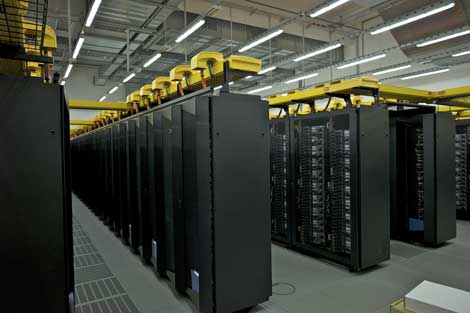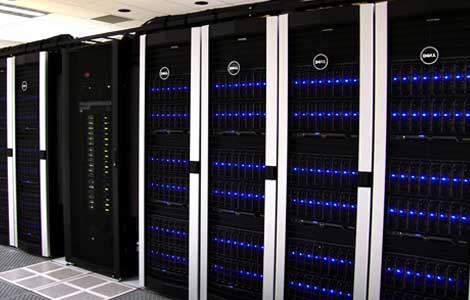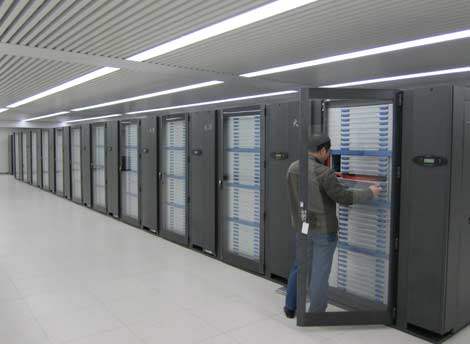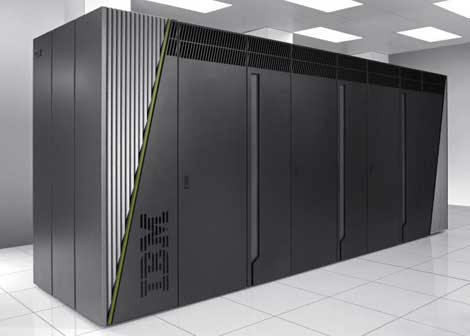We continue our illustrated review of the top finishers in the latest Top 500 list, which was released Monday at the SC12 conference in Salt Lake City, Utah. See part one for images of the five most powerful machines. We continue at number six.
SUPERMUC SUPERCOMPUTER, Leibniz Rechenzentrum, Munich, Germany

The SuperMUC system at the The Leibniz Supercomputing Centre (LRZ) weighs in at number six on the new list. It was built with IBM System x iDataPlex Direct Water Cooled dx360 M4 servers with more than 150,000 cores to provide a peak performance of nearly three petaflops, which is equivalent to the work of more than 110,000 personal computers. The SuperMUC system is Europe's fastest computer, and will be used to drive a wide spectrum of research - from simulating the blood flow behind an artificial heart valve, to devise quieter airplanes to unearthing new insights in geophysics, including the understanding of earthquakes.
STAMPEDE, Texas Advanced Computing Center

A newcomer to the top 10 is Stampede, which is scheduled to begin production in early January 2013 at the Texas Advanced Computing Center in Austin. Stampede runs on Dell PowerEdge C8220 servers using the Xeon E5 chips featuring Intel's Phi coprocessors and architecture, and will be one of the largest computing systems in the world for open science research. Stampede also contains 16 large memory nodes each with 1 TB of RAM and 32 cores, and 128 standard compute nodes each with an NVIDIA Kepler2 GPU, giving users access to large shared-memory computing and remote visualization capabilities.
TIANHE-1A, National Supercomputing Center, Tianjin, China

The Tianhe-1A, the most powerful supercomputer in the world as of November 2010.
The Chinese Tianhe-1A system at the National Supercomputer Center in Tianjin slips to eighth place in the latest survey, achieving a performance level of 2.57 petaflop/s (quadrillions of calculations per second). In 2010 the Tianhe-1A system took the top spot, but was dethroned by the K Supercomputer when the next TOP500 list was published in June 2011.
FERMI SUPERCOMPUTER, Cineca, Italy

A look at the IBM Blue Gene / Q systems powering the Fermi supercomputer at Cineca in Italy.
In ninth place is the FERMI system housed at Cineca, a non-profit consortium, made up of 54 Italian universities and research organizations. FERMI is composed of 10.240 PowerA2 sockets running at 1.6GHz, with 16 cores each, totaling 163.840 compute cores and a system peak performance of 2.1 PFlops. Each processor comes with 16Gbyte of RAM (1Gbyte per core). The system will be equipped with a scratch storage system with a capacity of 2 petabytes and bandwidth in excess of 100 GByte/s. FERMI will enable computational science of scale, and will allow Italian and European teams of researchers to perform computationally intensive, large-scale research projects attacking fundamental problems in science and engineering that require massive calculations. ISCRA (Italian SuperComputing Resources Allocation) and PRACE will manage the access to the supercomputer. The system is named for Enrico Fermi, the Italian-born nuclear physicist.
DARPA Trial Subset, IBM
We don't have much information yet about this system, operated by by IBM Development Engineering. The system is an IBM Power 775 supercomputer with 63,360 cores that achieved a score of 1.5 petaflop/s on the Linpack benchmark.
